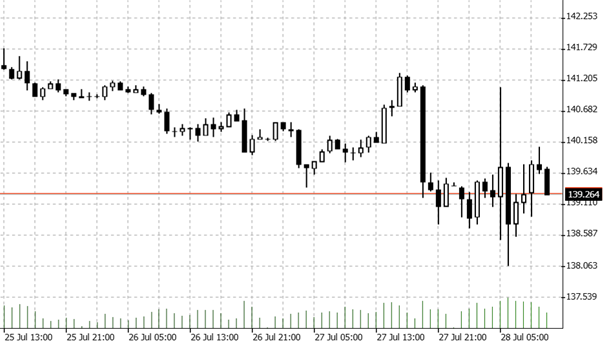

28.07.2023 – The Bank of Japan is making things exciting: On the one hand, it is still shying away from an official turnaround in monetary policy. And in doing so, it is disappointing the expectations of many yen bulls. However, the central bank’s first signal confirmed suspicions that the time could soon come.
USDJPY was recently torn back and forth, here the hourly chart. Which is hardly surprising given the contradictory signals.

Source: Bernstein Bank GmbH
Early Friday morning, the Bank of Japan (BOJ) announced its interest rate decision. Some market players had expected an official change in monetary policy by the new governor Kazuo Ueda. That did not come.
U-turn light
The central bank left the upper limit for ten-year government bonds at 0.5 percent after all. In addition, short-term interest rates remain at minus 0.1 percent. However, the BoJ surprised the financial markets by announcing an easing of its control mechanism for Japanese government bonds. Thus, the BoJ did keep its target for ten-year yields at zero percent. But then came the first crack in its previous monetary policy: the central bank said that from now on the 0.5 percent ceiling would only be a reference point and no longer a hard limit, as it wanted to make its easing program more flexible.
Nikkei largely confirmed
The BoJ had thus largely confirmed a report by the Nikkei news group, according to which the BoJ was discussing the yield control curve and a higher yield limit. Say: must allow rising interest rates. Nikkei is considered the mouthpiece of the central bank. What is not, can therefore still become. That means: possible rising real interest rates because of inflation – which makes the yen more attractive.
End of US Tightening in Sight
Meanwhile, there doesn’t seem to be much room left for the dollar in terms of interest rate hikes. As expected, the Fed has raised interest rates once again. The Federal Open Market Committee voted unanimously to raise the fed funds rate by 25 basis points to between 5.25 and 5.50 percent. However, the market assumes that this will soon be the end of the tightening in the USA.
The conclusion from all this: Traders and investors should pay attention to the yen whether the monetary policy turnaround is actually initiated. Apparently, some investors assume very well. The Wall Street Journal recently reported the end of large yen shorts: “Hedge funds have unwound their bets against the currency. We are curious to see what happens next and will keep you up to date!
_______________________________________________________________________________________________________________________________________________
The content of this publication is for general information purposes only. In this context, it is neither an individual investment recommendation or advice nor an offer to purchase or sell securities or other financial products. The content in question and all the information contained therein do not in any way replace individual investor- or investment-oriented advice. No reliable forecast or indication for the future is possible with respect to any presentation or information on the present or past performance of the relevant underlying assets. All information and data presented in this publication are based on reliable sources. However, Bernstein Bank does not guarantee that the information and data contained in this publication is up-to-date, correct and complete. Securities traded on the financial markets are subject to price fluctuations. A contract for difference (CFD) is also a financial instrument with leverage effect. Against this backdrop, CFD trading involves a high risk up to the point of total loss and may not be suitable for all investors. Therefore, make sure that you have fully understood all the correlating risks. If necessary, ask for independent advice. CFDs are complex instruments and are associated with the high risk of losing money quickly because of the leverage effect. 68% of retail investor accounts lose money trading CFD with this provider. You should consider whether you understand how CFD work and whether you can afford to take the high risk of losing your money.7
